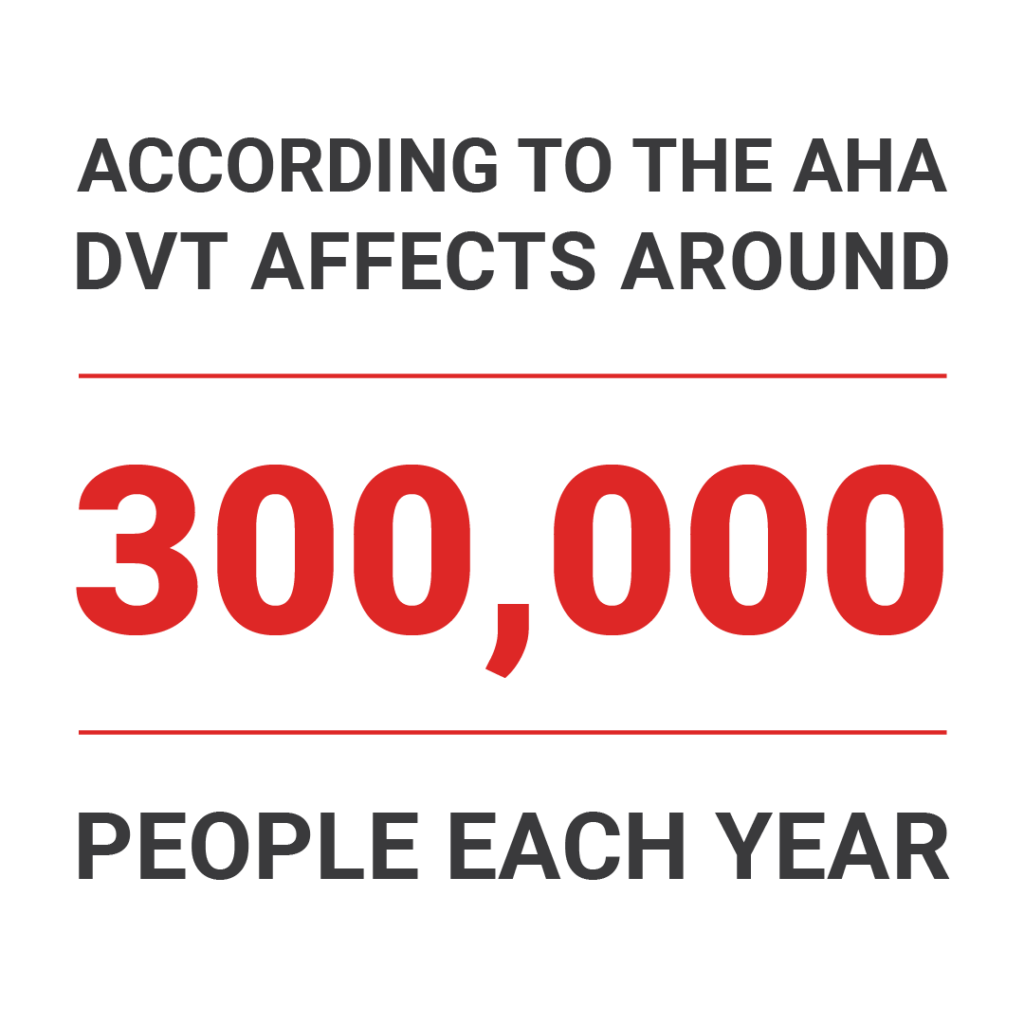DVT, or deep vein thrombosis, is a well-known risk following surgery. This type of diagnosis occurs when blood clots form in the deep veins and break off traveling through the body to the lungs or brain.
A post-surgical setting provides an ideal environment for a DVT to form. The body naturally forms clots after blood loss during the surgery, and circulation slows down because of a lack of movement during recovery.
What is deep vein thrombosis (DVT)?
Blood clots are lifesaving. The body uses this natural mechanism to prevent excessive bleeding; however, when formed in the wrong spot, blood clots can be deadly.
According to the American Heart Association, DVTs affect around 300,000 people each year.
DVT occurs when a clot develops in the deep veins and breaks off.
When a DVT is detected early, it can be treated.
If left unchecked, a DVT can be deadly as it travels to the brain, heart, or lungs.

According to the CDC, 10-30% of people with a diagnosed DVT will die within a month. Without preventative treatment, more than half of orthopedic surgery patients will develop a DVT. The American Academy of Orthopedic Surgeons suggests that surgeons try multiple methods to minimize DVT risk.
Despite the fact that DVTs are well understood, many facilities are not doing enough to prevent them.
Understanding Deep Vein Thrombosis: A Closer Look
The landscape of surgery is changing. More than half of orthopedic surgeries happen in an outpatient setting. While patients tend to prefer outpatient, it also means patients are not as closely monitored following the procedure.
Patients are most likely to clot between 2-10 days after surgery. In some cases, symptoms are mild or do not exist. Some common symptoms that patients should be aware of include:
- Leg pain or cramping
- Swelling
- Skin warm to touch
- Changes in skin color
- Chest pain
- Increased heart rate

It is difficult for outpatient centers when DVTs happen at home. It’s important to equip and educate patients about worst case scenarios during at-home recovery. Not only does this give the patients confidence but can help reduce readmission rates, which has a direct financial impact on the surgery center.
History of DVT Treatment
The first recorded case of DVT was in 1271 during the Middle Ages. A cobbler named Raoul was in his 20s suffering from pain and swelling in the right calf which extended up the thigh. His surgeon advised him to wait and see what happened with the pain. But, as DVT does, the symptoms grew more severe eventually leading to a leg ulcer.
The first evidenced-based treatment of DVT came in the 18th century. In 1856, Virchow demonstrated that DVT could be fatal, but doctors still didn’t have any effective treatment for preventing blood clot disorders.
In the late 19th century, the French utilized an immobilization reclining bed to treat DVT. For this treatment, patients would place their legs in iron sleeves so they could not move. Then, in the mid-20th century anticoagulants were introduced as a treatment for blood clots.
Today, it’s unlikely anyone will hear a surgeon advise a patient to “wait and see” when it comes to a blood clot and gone are the days of immobilizing iron boots. Fortunately, we now have much more advanced and effective medical devices for DVT prevention and treatment.
The Role of Medical Devices in DVT Prevention
Intermittent pneumatic compression devices were first used to decrease DVT after surgery in the 1970s. Although technology has changed, this technique is still utilized today.
In a hospital setting, patients can receive fabric wraps that inflate and deflate around their calves.
For outpatient surgeries where patients have a high risk for DVT, surgeons can prescribe a take-home device.
Types of Deep Vein Thrombosis Medical Devices
Medical devices are still utilized to help prevent deep vein thrombosis with a range of products available on the market today.
Intermittent Pneumatic Compression Devices: A Non-Invasive Approach
Intermittent pneumatic compression (ICP) devices are placed around a patient’s calf or foot. From there, the device periodically inflates and deflates, restoring blood flow.
Especially for patients who are at high risk for blood clots and a high risk for bleeding, IPC devices are known to reduce post-operative VTE, or venous thrombosis, rates.
It’s recommended this type of treatment is also paired with an anticoagulant medication.
Unfortunately, sometimes patients are beyond the prevention phase and need further medical attention for blood clot treatment or removal.
Catheter-Directed Thrombolysis: A Targeted Treatment
For nearly 30 years, catheter-directed thrombolysis has been utilized to treat DVT. For this treatment, a catheter is placed into the affected vein to dissolve the clot. However, one study suggests that this type of procedure is not highly effective. In fact, it isn’t recommended to use on elderly patients due to the risk of bleeding.
Another study says there are benefits to this type of treatment, but patients undergoing catheter-directed thrombolysis can cause bleeding. Bleeding paired with an intracranial hemorrhage can be fatal.
Thrombectomy Devices: Removing the Clot
If a patient has a clot, another option is clot removal. This is done via surgery. A cut is typically made above the clot and a surgeon will open up the vessel to remove the clot.
This surgery generally has successful outcomes and is not a major expense for hospitals. Also in a cost analysis study, this type of surgery does not require a lengthy hospital stay.

Making the Right Choice: Factors to Consider When Choosing a DVT Device
After taking the Caprini risk assessment, a clinician can determine if the patient is at high risk for a post-surgical blood clot-related complication.
Here are a few things to consider when deciding on a DVT device for high-risk patients:
Consider the Patient’s Health Condition
Patients needing preventative DVT devices may have the following complications:
- Weakened immune system
- Chronic conditions
- Old age
- Overall health such as BMI
DVT Medical Devices for ASCs
If determined that the patient would benefit from DVT prevention devices, there are several options on the market. Compression Solutions has a wide product line of DVT-preventative devices.
Some patients may benefit from a tubeless PlasmaFlow.
Some physicians may want DVT prevention paired with an orthotic and could consider the Triple Play unit.
For all devices, Compression Solutions has a team of medical billing experts that can work with the patient’s insurance on coverage.

Frequently Asked Questions About DVT and Its Treatment Devices
Are DVT Devices Safe?
Medical devices, like all treatments, must pass rigorous testing for safety and effectiveness before they are approved for use. Intermittent pneumatic compression devices are non-invasive and used by thousands of patients every day without incident. That said, no device is without risks.
Can DVT Be Treated Without Medical Devices?
For patients wanting to avoid a medical device, an anticoagulant can be prescribed to treat and prevent clots.
If you have more questions about DVT prevention and pneumatic compression devices, here is a full list of frequently asked questions.
Adopt PlasmaFlow or Triple Play as a DVT prevention device for your surgery center
If you are interested in hearing more about take-home or facility-based deep vein thrombosis prevention devices, contact our sales team today.
"*" indicates required fields
